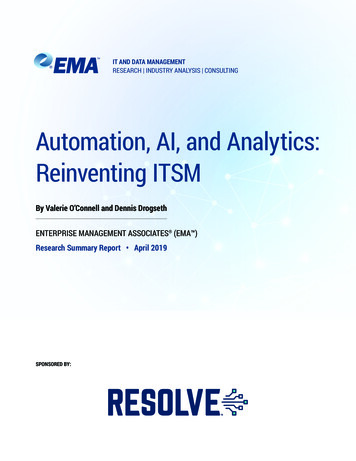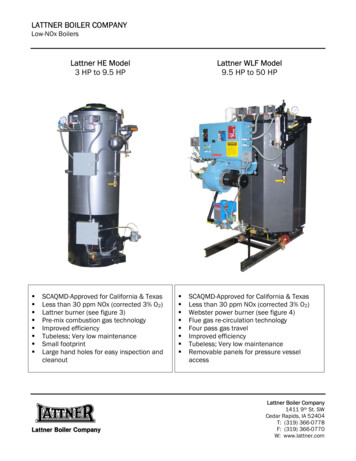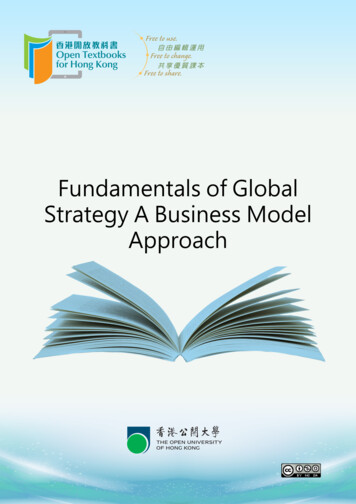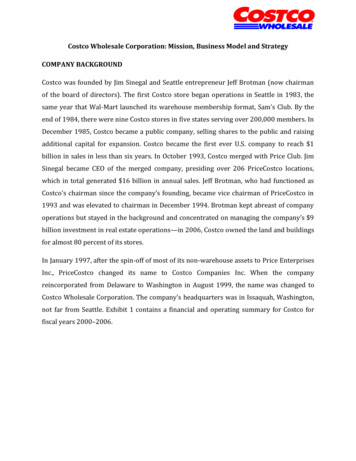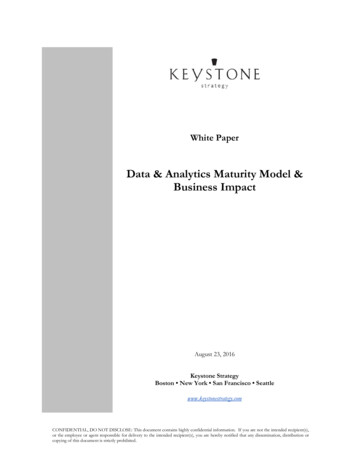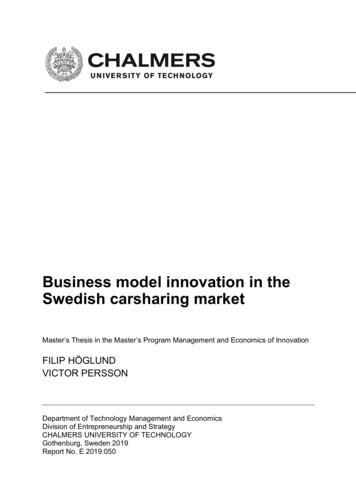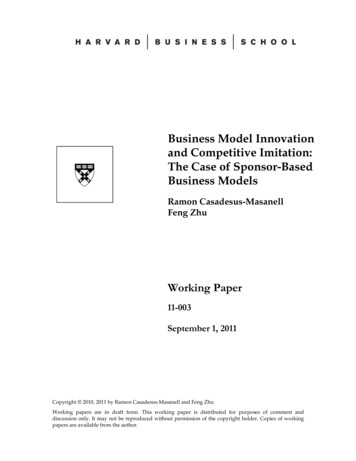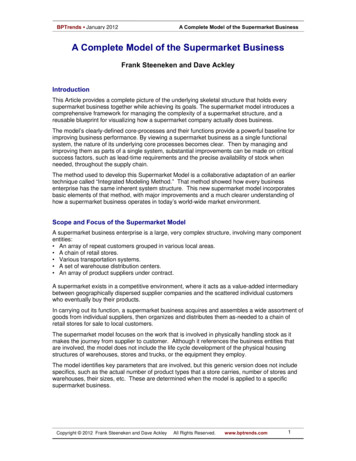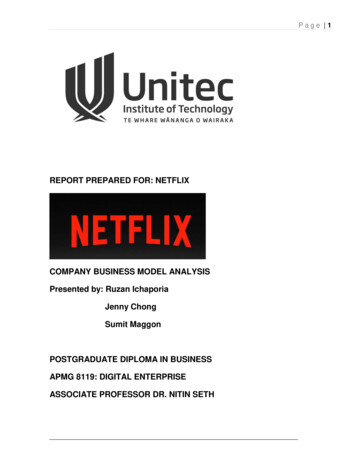
Transcription
Reinventing the business model of thenewspaper industry:electronic business models and the newspaper industryThe Wall Street Journal as case studyR. JohnsonA. GutiérrezMBA Master’s Thesis2010Blekinge Institute of TechnologySchool of ManagementSupervisor: Philippe Rouchy
“Disruptive technologies is a misnomer.What it is, is trivial technology that screws up your business model.”--Andy Grove, ex-CEO Intel
2
AbstractIn developing this thesis, we made an analysis of the newspaper industry in the UnitedStates, using The Wall Street Journal as a case study. This research project includesinformation and analysis on the evolution of Dow, Jones & Company (parent companyof the newspaper) and its direct link to the Wall Street Journal from its initial days andalong way this thesis highlights the changes that have been implemented between the19th and the 21st centuries. This research addresses the troubled business model of thenewspaper industry, asking why has it broken, how it broke, and essentially how can itbe reinvented?Our main research questions are: How did the old business model become damaged?How has The Wall Street Journal avoided the crisis? How are The Wall Street Journal'scompetitors responding to business model disruption? How can e-business models beadapted to assist the newspaper industry in reinventing its business model?Along the way, research questions were refined based on readings and interviews asgreater insight and understanding were obtained about the newspaper industry, itstraditional business model, its present predicament, and the various viewpoints as to thecurrent state of the industry, the future direction of the industry, and the e-businessmodel of the WSJ. A qualitative analysis of the business practices of the WSJ and itscompetitors and trends within the industry has led to the understanding that while yes,the business model of the industry is definitely broken, this is not necessarily true forevery news organization in the U.S. market, the region primarily focused on in thispaper.The rationale for using the case study approach is because The Wall Street Journalrepresents a unique and revelatory case in the newspaper industry. In the US market, theWSJ is one of the only newspapers that has a profitable e-business model. Usinganalytical generalization, a previously developed theory is used as a template withwhich to compare the empirical results of this case study. We use the Financial Times asa second example in this thesis because it occupies a similar niche in the newspaperindustry as the WSJ appeals to a similar customer segment.Although this case study focuses on the US market, we have also included informationon newspapers in other markets such as Norway and the UK because The Wall StreetJournal is an international newspaper, operating in a global marketplace, and todemonstrate how firms outside the US market have been changing and adapting their3
business model. Information on the Financial Times has been included because it is oneof the WSJ's closest competitors not just internationally, but also in the US market.In terms of our research questions, we discovered that the current business model forUS-based newspapers dates back to the 18th century and up until the mid-1990s, hadbarely changed. And that a combination of factors have contributed to the destruction ofthe traditional model of the newspaper industry including business model disrupters,changing consumer habits and audience fragmentation.Among the conclusions draw from the research include, that in the 21st century, thebusiness model of the newspaper industry will continuously face disruption due tochanges in consumer habits and preferences as well as technology. Organizations needto adopt a framework that includes continuous innovation, simple rules, and moreflexible processes applicable to its current customer segment and potential customersegment in order to ensure that they are able to remain competitive in this ever changingand shifting environment. Individual firms perhaps need to engage in creatingdisruption themselves and avoid complacency.4
AcknowledgmentsWe would like to thank John Murray, Vice President of Audience Research, NewspaperAssociation of America; Joel Budd, Media Editor, The Economist; Paul Markillie,Innovation Editor. The Economist, the Library of Congress; and the Duke UniversityLibraries for the use of their digital collection on the emergence of advertising in theUnited States. The Newspaper Association of America assisted in providing whitepapers, reports, circulation information and surveys regarding the United Statesnewspaper industry. We would also like to thank Phillippe Rouchy for his assistancethroughout the research and writing process.5
Table of l framework8Literature review11Methodology22Chapter 1: The Wall Street Journal and its business model evolution26Chapter 2: Why is the current business model broken?31Chapter 3: How have competitors addressed transforming the traditionalnewspaper business model and e-business model innovation?45Chapter 4: Suggestions for business model reinvention49Chapter 5: Prospective remarks43Chapter 6: Conclusion69References756
TablesTable 1Print advertising revenue in contrast to online advertising revenuefor newspapers in the United States36Table 2US newspaper circulation percentage decline 2003- 200938Table 3Daily newspapers in US 1940 – 200039Table 4Daily newspaper advertising revenue percentage change 1985 – 200942Table 5News sources for the US market48Table 6Native internet business model possibilities for the newspaper industry68-697
Theoretical frameworkIn developing the theoretical framework of this thesis dependent and independentvariables were identified in our research. The dependent variables are comprised ofcurrent issues within the newspaper industry. These consist of: falling circulation,decrease in advertising pages, declining advertising revenue, falling readership for printnewspapers, and web advertising not making up for the loss of revenue from printadvertising (Collis 2010, Franklin 2010, van der Beek 2005, Hillman 1999). Theindependent variables are comprised of issues outside the industry which are impactingnews organizations and consist of: changing consumer habits, business modeldisrupters, audience fragmentation and the growing number of new sources andplatforms available for acquiring news and information (Collis 2010, Huang 2009,Meyer 2009, van der Beek 2005, Hermida 2010).In Reinventing Your Business Model by Johnson, Christensen and Kagermann (2008),the authors detail a framework for business model reinvention (e.g., when it shouldhappen, why it should happen) that is used in this thesis. Their key assumptions utilizedin this paper are:1.) New business models are needed when there have been significant changes tothe four key elements of the existing model, these core elements are comprisedof a.) the customer value proposition (CVP) b.) profit formula c.) key resources,d.) and key processes2.) Business models need to have the flexibility to change in their early years.3.) Creating new growth requires venturing not only into unknown market territorybut also into unknown business model territory.4.) The new business model should be both new to the company and a gamechanger to the industry or marketThe key components of a business model are it's CVP, profit formula, key resources,and key processes. How does a newspaper firm know when it needs a new businessmodel? Although Johnson et al believe that a new model is needed “When significantchanges are needed to all four elements of your existing model,” yet the authorsacknowledge that these four components are interdependent (Johnson 2008), thereforewaiting for radical changes to each of the four components could result in catastrophicproblems for a company. The concept utilized in this thesis is based on the theory thatthe four elements of a business model are interconnected (Johnson 2008).8
And that it is better for an organization to be proactive and start implementing changesimmediately so that companies can deal more effectively with business modeldisrupters.Although the key components of a business model identified by Hedman and Kalling(2002) slightly differ from those identified by Johnson, Christensen and Kagermann, thecore elements are the same and Hedman and Kallig acknowledge that the bits includedin the model are dictated by purpose (Hedman, Kallig 2002). Both Johnson, et al(2008) and Hedman et al (2002) agree that the key components of a successful businessmodel are the customer, resources and processes and that the components are allinterrelated (Hedman, Kallig 2002).Johnson et al identify “five strategic circumstances that require business model change:”the ones applicable to this paper are: 1.) the opportunity to bring a job-to-be-done focuswhere one does not yet exist 2.) the need to fend-off low-end disrupters and 3.) the needto respond to a shifting basis of competition.(Johnson et al 2008).Johnson et el (2008) believe that business models are more likely to implement changeand deliver acceptable results if the firm is “unfettered by the often negative influencesof [the] core business.” (Johnson et el 2008).9
AimThe aim of this thesis is to identify innovative business models for the newspaperindustry and to provide the industry with a basic framework to promote flexibility andadaptability that will enable firms to continuously reinvent themselves and not only beable to respond to business model disrupters but also to become business modeldisrupters themselves.In this thesis, the focus is on the US market and The Wall Street Journal is used as acase study in order to analyze the business model of the newspaper industry andbecause it is one of the only newspapers in the United States that has a successfulbusiness model for both its print and electronic editions. With this case study, thestructure of the newspaper industry is investigated and the lessons drawn from thisstudy are generalizable across the entire newspaper industry and could also be appliedby other media companies in areas such as film and music (Yin 2009).10
Literature reviewWhen is a new business model needed? Changing trends, entry of low-end disrupters,the shifting basis of competition and the opportunity to bring a job-to-be-done focus toyour plan are key signs of the need for business model reinvention (Johnson et al 2008,Sterling 2008, Evans 2007,Wirtz, et al 2010, Pew Research Center 2009).This thesis, which focuses on business model reinvention for the newspaper industry,uses The Wall Street Journal as a case study and focuses on the United Statesmarketplace. We have used the The Wall Street Journal because: it represents a uniquecase in the newspaper industry; it is the largest newspaper in the United States; and it isthe only newspaper among the top 25 newspapers in this market with rising circulationand a successful e-newspaper business model (Collis et al 2010, van der Beek 2005,Editor & Publishers 2010, Audit Bureau of Circulation 2010).There is an abundance of literature on approaches and classification of e-businessmodels (van der Beek, 2005, Rappa 2004, Bambury 1998, Nel 2010), advise forcounterattacks to business model disruption (Sterling 2008, Christensen 1997) andbusiness model innovation and reinvention (Johnson et al 2008). There is a dearth ofscholarly literature available detailing current e-business models utilized by newsorganizations (Francois 2010). In order to ascertain how the old business model brokeand what has caused the newspaper crisis (Collis 2010, Francois 2010, van der Beek, etal 2005) requires an examination of the traditional and current business models andtrends of the newspaper industry. Collis (2010), Francois (2010), and van der Beek et al(2005), as well as Picard (2002) and Hillman (1999) provide this information.Hillman (1999) is rich resource on The Wall Street Journal and its interactive businessmodel. Although the article was written in the late 90s, the e-business model of thenewspaper is the same today as it was 11 years ago. Hillman (1999), who had directaccess to key managers of Dow Jones & Company, parent company of The Wall StreetJournal, clearly details the company's strategy regarding the WSJ.com in her casestudy. This is the most current scholarly article specifically on this newspaper whichfocuses on the WSJ.com. In this work, the author evaluates online competitors andprovides an overview of the the newspaper industry in the US market. The informationincludes very little analysis but provides more of an overview of the state of The WallStreet Journal in 1999. Although her article pre-dates numerous business modeldisrupters which are currently adversely affecting the newspaper industry's revenuemodel, this paper is one of the few articles that provides background information on the11
interactive division of The Wall Street Journal. Wendt's (1982) book provides generalbackground information about the company, the origins, and the business philosophy ofthe owners.A comprehensive overview of the decline of the newspaper industry was provided bypeer-reviewed literature that also presented background information on the the historyof the newspaper industry and its traditional business model (Collis, et al 2010,Loebbecke 2000, Huang 2009, Franklin 2010, Peters 2010).Although social networking platforms were in their infancy when van der Beek et al inCreating Value From Digital Content (2005) conducted their research on e-businessmodels and the newspaper industry, the structures that the authors present, based onmodels derived from Rappa (2004, 2000) and Bambury (1998)'s taxonomy are stillvalid. The authors exhaustively detail available web-based business models fornewspapers such as paid content, free online/advertising supported news, and meterednews (van der Beek et al 2005). The structures of which are drawn from Rappa'staxonomy of internet business models which include the subscription model (paidcontent), the advertising model (free online/ad supported news) and the utility model(metered models) (Rappa 2004). The subscription model and the advertising model areused by WSJ.com while the FT.com uses a hybrid of the utility (metered/measuredusage) model, subscription model, and the advertising model. Neither Rappa nor vander Beek identify the subscription and the advertising business model as being directlytransplanted from what Bambury refers to as “real-world business models” (Bambury1998). Featherstone and Ellis (2005) observed that “much of the existing e-businessliterature has been fashioned from a perspective which is external to the web.” Thisassertion is basically inaccurate. Rappa's taxonomy of e-business models alsoencompasses native internet business models—models that are not external to the web,such as the community/open-source and affiliate models along with his infomediarymodel that mirrors Bambury's information barter model, which is a native internetbusiness model (Bambury 1998).There is a dearth of peer-reviewed literature focusing on the affect of social networkingand social media on the newspaper industry's business model. Twittering the News: TheEmergence of Ambient Journalism,” (Hermida 2010) is one of the few academic studiescurrently available that explores this relationship between old media and microblogging yet his study primarily focuses on content and not business models. Hermida(2010) grounds his analysis of the effect social networking tools and micro-bloggingwebsites are having on the journalism trade within the theoretical framework of humancomputer interaction. His research complements studies on changing consumer habits inregards to media and information consumption (Collis et al 2010, Picard 2002,12
McKinsey 2009, Hermida 2010). Although McKinsey's empircal study is more a surveyof the media consumption of teenagers.Hermida argues that micro-blogging--the dissemination of information using 200 or lesscharacters to an audience of minute or infinite numbers through a singular platform suchas Twitter, are awareness systems that “.are always on and move from the backgroundto the foreground as and when a user feels the need to communicate.” or receiveinformation (Hermida 2010). His paper explores how technology is transformingjournalism, the way in which journalists collect and disseminate news and information,and the changing consumer habits for information consumption.Johnson, Christensen and Kagermann (2008) identify four primarily components thatcomprise the business model of a generic company: 1.) Customer value proposition(CVP) 2.) Profit formula 3.) Key resources and 4.) Key processes. Hermida (2010) doesnot set out to define parameters for a new business model for the newspaper industry orto recommend a new business model, but with in his theoretical frame work, he conveyshow these always-on awareness systems can be utilized to improve key resources andthe key processes involved in dispersing information to consumers, and presents ideasfor a new CVP that provides consumers with the opportunity to consume informationvia an “.always-on asynchronous awareness system [that] informs but does notoverburden” so that a user does not suffer from information over load (Hermida 2010).Since Hermida's (2010) focus is mostly on social networking and “always-on awarenesssystems,” which he refers to as “ambient journalism,” the author fails to explore howsuch systems and tools can be applied to the profit formula of a newspaper's businessmodel. The author only envisions how these tools can be used to create value for theconsumer but not how the tools and concepts can be used to create value for a firm.Robert G. Picard, a widely referenced and renowned scholar and media expert wroteEconomics and Financing of Media Companies, a definitive textbook on the financialside of media organizations that encompasses the newspaper industry (van der Beek etal 2005, Compaine 2003). Picard's writing as well as other available scholarly literatureon the newspaper industry tend to deviate from rigorously examining businessstructures to rigorously examining the editorial content of newspapers (van der Beek2005, et al, Sterling 2008, Picard 2002, Collis et al 2010, Franklin 2010, Hermida2010). Literature emphasizing improving content as a solution to combating businessmodel disruption is prevalent (Sterling 2008, van der Beek et al 2005) and using thisapproach as a way to improve a firm's profit formula (van der Beek, et al 2005). Theseare only strategies for improving the CVP component of a business model. Adding newsections and improving content is the tool newspapers traditionally have used torevitalize their print-business models (Huang 2009). The authors' solution for the13
current problems in the industry focus more on reinvigorating the old model andmaintaining the status quo. Conversely Chesborough (2010) believes that “.when it isclear that the old business model is no longer working.business model experimentationbecomes so important and this theory is supported by Johnson, Christensen andKagermann (2008). The Wall Street Journal used this template of content improvementto revitalize the print newspaper at the beginning of the 20th century and in the 1950s(Wendt 1984). Johnson, Christensen and Kagermann (2008) believe that the core of asuccessful business model is its revenue model and profit formula, which mostacademic writing on this area fails to explore with the exception of Sterling (2008). Orin the case of Francois (2010), who only provides an overview of pre-existing models.Johnson, Christensen and Kagermann assert that only after identifying a valueproposition for both the customer and the profit formula for the business, should a firmthen preoccupy itself with its its key resources (Johnson, Christense
The Wall Street Journal as case study R. Johnson A. Gutiérrez MBA Master’s Thesis 2010 Blekinge Institute of Technology School of Management Supervisor: Philippe Rouchy “Disruptive technologies is a misnomer. What it is, is tr
